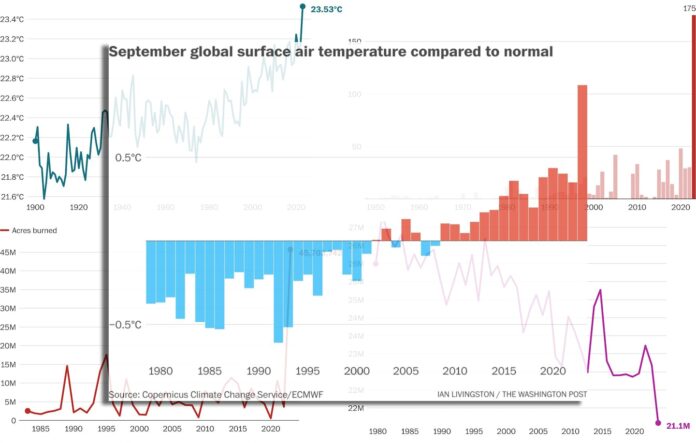These climate change indicators have entered uncharted territory both because of long-term warming driven by human activities and a boost from a powerful El Niño event — or warming of ocean waters in the tropical Pacific that sends heat into the atmosphere worldwide.
These five charts reveal how out of step 2023′s planetary warmth is compared to the past.
September’s unprecendeted temperature spike
No previous September was close to as warm as last month — which was 0.93 Celsius above normal, according to the Copernicus Climate Change Service of the European Union.
The margin by which it was warmest September on record was by itself record-setting. And it followed a record-hot summer and the Earth’s hottest month and day during July.
Now, this month is on track to be the warmest October on record by a wide margin and there’s a greater than 99 percent chance that 2023 will be Earth’s hottest year on record.
Miami’s relentless and punishing heat
As a microcosm for the globe, we can look at the temperatures in Miami in recent months. Even in a place known for hot weather, the temperatures were unlike anything previously observed.
Stifling heat and humidity began late in the spring and continued well into October. So far this year, it has registered 175 hours with a heat index — a measure of how hot it feels factoring in humidity — of 105 or greater. That’s more than three times the previous record.
Most of the area from U.S. Gulf Coast into the Caribbean is on track to post a record warm year. Puerto Rico has witnessed heat alerts on an unprecedented 135 days.
Excessive heat and humidity were observed not only across a broad swath of the tropics, but also in repeated waves in North America, Europe, the Middle East and East Asia through the summer months.
Canada fires are without precedent
Canada’s fire season explosively erupted with a barrage of lightning-induced fires across Canada’s west in early May. It came at a time of deepening drought and record-challenging warmth in much of that region.
By mid-May, the first of several smoke outbreaks swept over Calgary. Later smoke incursions would invade much of the eastern two-thirds of the Lower 48 states.
By late June, the area burned over Canada had already set a modern record. By the end of the season in October, over 45 million acres had gone up in smoke, an area more than double the previous record.
North Atlantic sea surface temperatures
Boosting the heat over land areas, global oceans have run incomprehensibly warm for most of the year.
“It’s like we fast-forwarded by 50 years in 2023,” wrote Brian McNoldy, a tropical weather researcher at the University of Miami, alluding to projections of future climate change which call for steep increases in ocean temperatures.
The North Atlantic has been especially warm since spring, with temperatures throughout the summer outdoing previous records by significant margins. The Gulf of Mexico also reached record highs while 100-degree water temperatures were observed off Florida’s southeast coast.
One of many consequences? An active Atlantic hurricane season, despite El Niño — which typically subdues storm activity.
Record low global sea ice maximum
Sea ice is critical to keeping the planet’s heat in check, and its total area has descended to its lowest level in the satellite record.
September into early October is usually when sea ice levels in the Antarctic climb to their greatest extent, following the continent’s dark, frigid winter. This year, the ice extent set a record low for the time of year. Arctic sea ice — which reaches a minimum around the same time — dropped to its sixth lowest level on record. The net effect of the depleted ice at both poles was a record low global extent.
“There is growing evidence that the Antarctic sea ice system has entered a new regime, featuring a much stronger influence of warm ocean waters limiting ice growth,” wrote the National Snow and Ice Data Center in a review of the remarkably low September ice extent.



